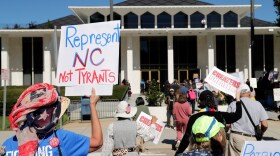This story first appeared in the WUNC Politics Newsletter. To subscribe for a free weekly update on North Carolina politics, click here.
With news that GOP state Senate leader Phil Berger is open to redrawing Congressional district lines – as other states have been doing – I wondered: Can Republicans give themselves an extra seat here without running the risk of making a safe GOP seat more competitive for Democrats?
I found the answer on the legislature’s own website, where unused draft maps from previous redistricting efforts in 2021 and 2023 are still online.
In some of those maps, creating a Republican-friendly 1st District could put other GOP districts in play.
But then I found a draft map filed by Senate redistricting leaders two years ago before they settled on the current map.
The Princeton Gerrymandering Project analyzed that map and found it would likely yield three safe districts for Democrats – and 11 safe districts for Republicans. Incumbent Democratic Reps. Valerie Foushee and Don Davis appear to be double-bunked.
The district shapes are quite creative: My house in Wake County would share the same representative as Emerald Isle at the coast. At another spot in Wake County, the 2nd district is only as wide as the Holly Springs Salamanders' baseball stadium it cuts through.

“It would also move 29.4% of North Carolinians – nearly 3 in 10 – out of their current districts and into a new district,” Princeton Gerrymandering Project’s Sam Wang told me. “It would not only affect District 1, but also Districts 8 and 13, which are currently held by Republicans.”
Wang cautioned that “it seems like a disruptive risk to take for the sake of a single seat, which might not even be determinative in who controls the House in 2027.”
But because Davis’ northeastern North Carolina district is already highly competitive, Western Carolina University political scientist Chris Cooper said “they don't need that much of a shift to make a swing district into a Republican district.”
I asked Cooper why Republicans left this map on the cutting room floor two years ago. Fear of a successful legal challenge may have played a role, he said.
“If they had drawn (the 1st District) to be more Republican, the probability of lawsuits would have been greater,” Cooper said, but “the tide has shifted over the course of the last two years … it appears that it's harder than ever, in some ways, to demonstrate a Section 2 (Voting Rights Act) claim and get it heard by the courts and with judges on your side.”
Just last week, a federal judge rejected a racial gerrymandering challenge to the current N.C. Senate maps.
And while North Carolina lawmakers are prohibited from mid-decade redistricting for state legislative districts, Cooper says there’s no prohibition on mid-decade redraws of Congressional maps.
“There's a norm that we don't do it,” he said. “But as we've learned with a lot of things in American politics, norms can be broken with no legal consequence.”
The legislature is scheduled to return Oct. 20, so we’ll likely find out then if redistricting is on the agenda. Wang says state courts here are unlikely to stop any plans in the short term.
"North Carolina has few guardrails on gerrymandering," he said. "The only meaningful one is the state Supreme Court elections of 2026 and 2028."
That's not to say that opponents of partisan redistricting wouldn't try to block any changes with a lawsuit. "My best guess is, if they were to redraw, the day they passed it, it would have a lawsuit filed before the clock turned 5 o'clock," Cooper said.







